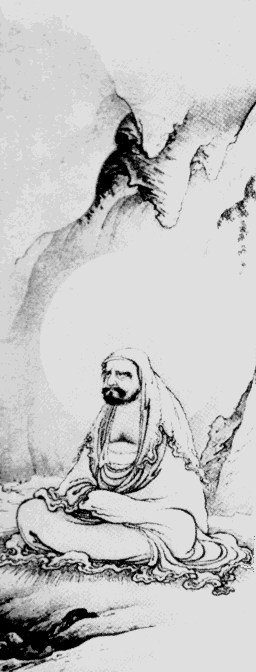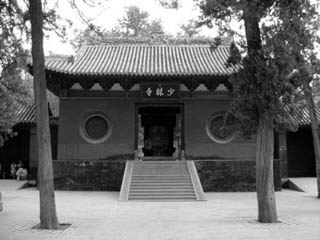First symptoms of the certain kind of fights had already appeared in China under the reign of the Zhou dynasty (11th century-256 BC). In the period of warring states there appeared a lot of strategists that emphasized the importance of wushu during building of the strong army. In Sunzi, the oldest surviving Chinese book of war arts, there is stated „the fight and attack exercises strengthen a physical condition of the warrior“. During the reign of Qin, Han and Jin dynasties ( from 221 BC till 6th century AD) there occurred a boom of martial arts, and where performances of wushu masters began to grow apart from fights in the form of shadow exercises without a weapon and with weapons. In 5th and 6th century AD wushu was also strongly influenced by philosophical trends of Buddhism and Taoism.
Bodhidharma 
In the year 526 or 527 AD under the reign of the Liang dynasty Indian Buddhist monk Damo (Bodhidharma) came to China. His task was to propagate and spread čchan (zen) Buddhism in China. Damo belonged to the Mahajána school, which included Tibetan and Zen Buddhism. He was invited to the audience with the emperor based on recommendation. But the emperor did not like Dam´s theory and therefore Dam left for the Henan province to the Shaolin temple, where he spent the rest of his life.
Shaolin monastery
The Shaolin monastery was founded in the Deng Feng mountains in the Henan province in the year 377 AD. But local monks were practising Buddism from the beginning and did not pay much attention to their physical condition. When Damo came in the temple, he did not understand the temple´s superior and therefore went to a near cave, where he spent 9 years with meditations. When he saw after his return that monks are in the bad physical condition because they spent a long time with meditations and had a low physical activity, he made up the excercise for them called “18 lohan hands (Lo han shi ba zang). It concerned the set of exercises focused on stretching of muscles in static positions. But concurrently the exercises included self-defence movements that monks learned to use them for their defence against bandits. Damo proceeded from his knowledge of ancient Indian fighting systems and breathing exercises during setting up of these exercises. This systém was further elaborated into more difficult systems that included more movements until the complex self-defence fighting system was formed. The Shaolin monastery became known in whole China and also beyond its border especially thanks to fist fight techniques and techniques of the fight with weapons, especially with a long bar.
 The Shaolin monastery gradually became a cradle of Chinese kungfu, where were formed other fighting styles. A number of monasteries, where monks practised kungfu, was increasing, and kungfu was spreading out. Although monastery monks lived in the closed society and protected their martial art against outside world, the martial art was gradually reaching the society at that time and there were established private schools of martial arts. But the monasteries further remained as the centre of kungfu martial art.
The Shaolin monastery gradually became a cradle of Chinese kungfu, where were formed other fighting styles. A number of monasteries, where monks practised kungfu, was increasing, and kungfu was spreading out. Although monastery monks lived in the closed society and protected their martial art against outside world, the martial art was gradually reaching the society at that time and there were established private schools of martial arts. But the monasteries further remained as the centre of kungfu martial art.
